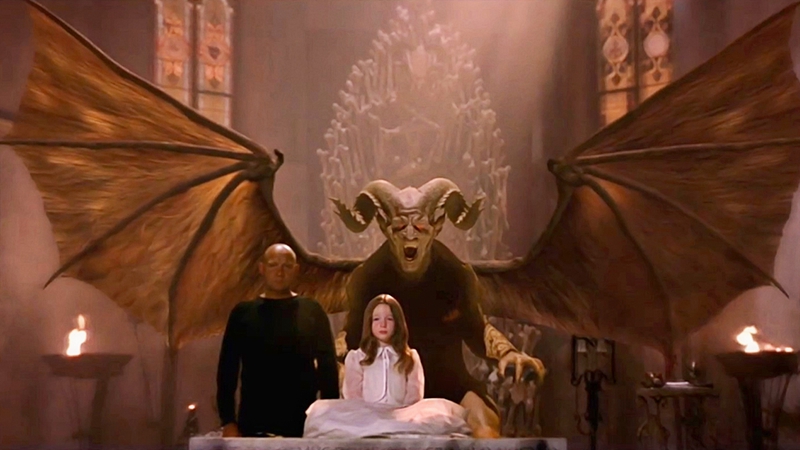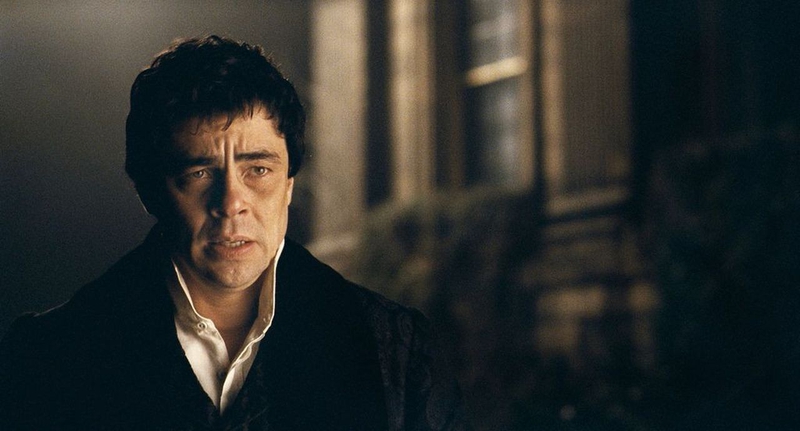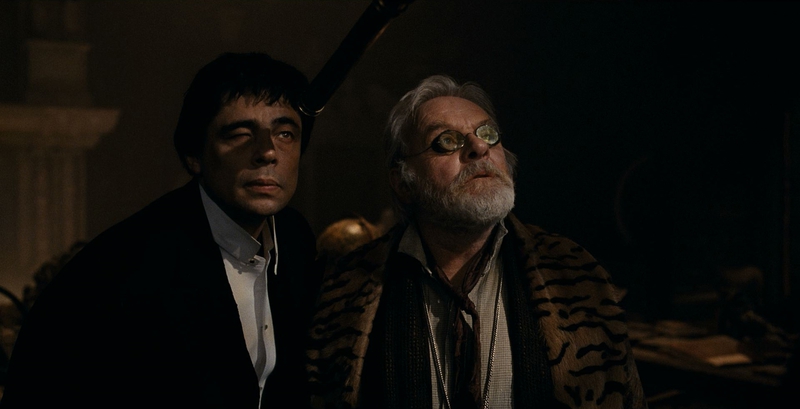Stratton Leopold has been in the film business for five decades, starting in his native Georgia as an actor (1975’s Kiss of the Tarantula) and moving up to casting and assistant director duties on locally lensed Italian horror films such as 1979’s The Visitor and 1981’s The Last Shark (a.k.a. Great White). He then served as production manager on the John Carpenter classics Prince of Darkness (1987) and They Live (1988), and discusses all of these genre credits in the current FANGORIA #13. Below, he talks more about Carpenter and recounts his producing experiences on a trio of studio fright and fantasy productions.
Leopold’s résumé encompasses all kinds of work in dozens of movies in all genres, and he notes, “I spent twelve years in Atlanta, learning my trade. I was happy there—it was a burgeoning market—but people said, ‘If you want to do more in this industry, you have to go to LA.’ ” Branching out into productions in other states led him to hook up with Larry Franco, Carpenter’s frequent producer and AD. “I met him when we were prepping a movie in Texas that Hank Moonjean [Hooper, Sharky’s Machine] was producing. That picture never happened, and Larry called me and said, ‘I’m making these two little pictures with Carpenter, would you like to come do them?’ and I said, ‘Sure.’ Larry is still my best friend in Los Angeles.
“John’s and my careers diverged after [Prince of Darkness and They Live],” Leopold continues. “I got involved with Paramount, and John married Sandy [King, who became Carpenter’s producer]; he and Larry stopped working together, and that was my big connection. I’d see John occasionally because he would have breakfast at a place in the Valley, and I’d see him there, and we’d shoot the shit. We took different paths, and I started getting more into action.”

His credits in that genre include executive-producing The Sum of All Fears, Paycheck and Mission: Impossible III among others—but before those big-ticket films, he was called in to help out on an even bigger one: Terry Gilliam’s ambitious, troubled 1989 fantasy epic The Adventures of Baron Munchausen. “I was brought onto that by Richard Soames of [completion guarantor] Film Finances,” Leopold says. “I had just finished a movie in Montana, I forget the name of it, and I didn’t really want to go. I remember being in Richard’s office, lying on the sofa, saying, ‘I’m tired.’ He said, ‘You’ve got to go to Spain for me, it’s a short gig,’ cajoling me to do it for him. So I said, ‘OK, I’ll go for a few weeks.’
“I flew to Spain and met Terry, whom I only knew as a Monty Python guy. I didn’t know at that point that he was American. I said, ‘You’re a Yank!’ and he said, ‘Yeah.’ I said, ‘I thought you were a Brit.’ In his head, he is, really. It was an interesting relationship, because Terry’s probably one of the most creative guys I’ve ever met. We did fight some, because there was no limit to his creativity. We had all the toys, but there was always room for more. Specifically, with the Vulcan sequence, Terry wanted to film it in an actual mine, an open pit. I said, ‘No, it’s the rainy season, we can’t do that. We’ll shoot it on Stage Five at Cinecittá.’ We had quite a few words about that. We had a great designer, Dante Ferretti, who did a fabulous job, thank God, but Terry was constantly attacking me because of that. I said, ‘Terry, I’ve got to think of the picture; we can’t just sit and wait when it rains.’”
In the end, Baron Munchausen became an insufficiently marketed box-office flop, despite all the imagination and money on the screen. “It’s a shame what happened to that picture, because David Puttnam was in charge of Columbia when we started, and then he got fired and replaced by Dawn Steel, and that was a different story. Before Dawn Steel came in, we were spending tons of money, and we had [insurers] Lloyd’s of London and all kinds of people around, and there was nobody at the studio. I’d call over there, and the best I could do was get an attorney or an assistant attorney on the phone. And I was like, ‘Guys, we’re dumping…’ I forget the number, millions of dollars a week, whatever it was, ‘I need some guidance here from the studio.’”

After making the move to Paramount, one of Leopold’s first features there was 2000’s Bless the Child, the Chuck Russell-directed supernatural thriller with Kim Basinger trying to protect her little niece from Satanists. For Leopold, some of the most memorable moments involved the finale, which takes place at an abandoned church where the cultists plan to hold a Black Mass. “We built that in Oshawa, northeast of Toronto, in a former sugar refinery that had 80-foot ceilings. The entire church and the hill up to it, interior and exterior, was all constructed. I remember when it was dressed, we looked at it and said, ‘Oh my God,’ because it was very scary stuff. We had priests, rabbis, everybody blessing the thing.
“I had discussions with the director about the people in that church, specifically, talking about the extras. He was saying, ‘I want Goths, I want people in chains,’ and I told him, ‘No, get insurance salesmen, get grandmothers; that’ll scare the shit out of people, because they won’t expect that!’ So we had a mixture in there. We had to reshoot part of that in LA, and reconstruct the altar on a stage at Paramount.”

Far more extensive reshoots were undertaken on The Wolfman, Universal and director Joe Johnston’s 2010 reboot of the classic monster character, on which Leopold was a co-producer. “That picture didn’t test well initially, and the studio wanted more action,” he relates. “So we shot more action—incredible stuff, a lot of which is not in the movie. We tried a lot of things, some of which we failed at, some of which we succeeded. We had great actors, obviously, but they were throwing money at it to try to fix it.”
That strong cast is headed by Benicio Del Toro as the tormented, transforming Lawrence Talbot. “Benny had lots of ideas. He had researched wolves and how they use their tongues, all kinds of things. At one point, he said, ‘I want to do a scene where I’m running through the woods at night, and I stop by a puddle, and I see my reflection and react, and then a butterfly lands on my nose.’ I said, ‘Benny, butterflies don’t fly at night. What are we going to do?’ He was constantly pitching ideas to Joe, and I’d be sitting with them saying, ‘Yeah, Benny, that’s good, but this is an expensive movie, and that’s half a night’s shooting!’”
Leopold has especially positive memories of Anthony Hopkins, who plays Lawrence’s father, Sir John Talbot. “He was a wonderful man. I have a story about him: When I lived in New York, I saw the play Equus twice, once starring Richard Burton, and once with this unknown young actor named Anthony Hopkins. When I saw it with Hopkins, I had a pretty good seat, probably halfway down in front. And in the middle of the first act, he did something that Burton did not. He stopped, leaned over, and apparently said something to the first row, and then continued with the play.

“Flash forward thirty-five years: I was sitting there with Hopkins, and I said, ‘Tony, I saw you on Broadway in Equus, and you did something I’d never seen done before: You addressed the front row.’ He looked at me and said, ‘You were there that night?’ and I said, ‘Yeah.’ He said, ‘What it was, this guy kept talking, and I leaned over and said, “Would you like me to start the first act over for you, sir?”’ [Laughs] He was astounded that I happened to be there, and now we were working together.”
Leopold closes with another story about the actor that involves his second career running a longtime family business: Savannah, GA’s legendary Leopold’s Ice Cream (and a SPOILER for those who haven’t seen The Wolfman). “We shot some green screen in Los Angeles, primarily with Hopkins. Since we were back in the States, I had ice cream shipped to the set, as I normally do. Hopkins was half in werewolf makeup; he had most of the head on. I said, ‘Tony, would you like some ice cream?’ and he said, ‘No, I’m on a diet, I can’t.’ But his assistant was eating it and said, ‘Tony, this stuff is great, you’ve got to try some.’ So the craft services guy shot this picture of Hopkins as a wolf lapping up my ice cream [laughs]. Which he enjoyed greatly!”
You can read more from this interview in FANGORIA issue #13.






